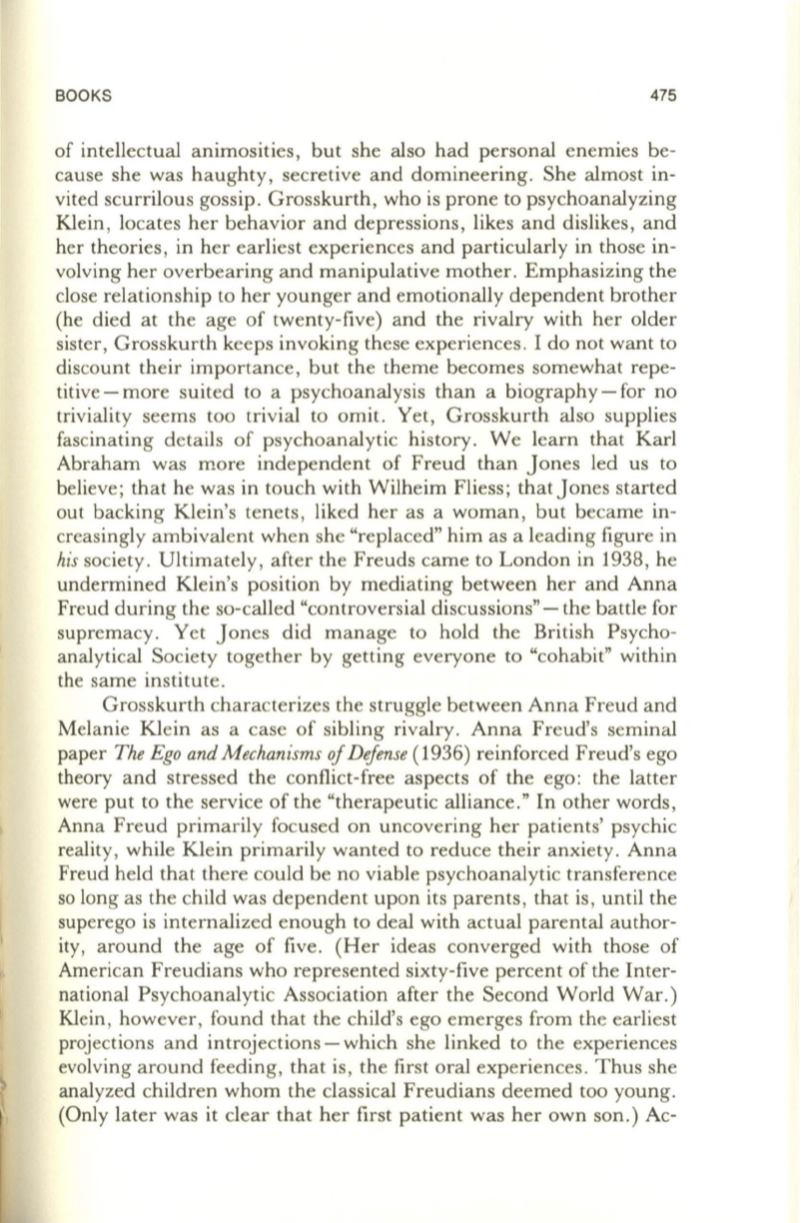
BOOKS
475
of intellectual animosities , but she also had personal enemies be–
cause she was haughty , secretive and domineering. She almost in–
vited scurrilous gossip. Grosskurth , who is prone to psychoanalyzing
Klein , locates her behavior and depressions, likes and dislikes, and
her theories , in her earliest experiences and particularly in those in–
volving her overbearing and manipulative mother. Emphasizing the
close relationship to her younger and emotionally dependent brother
(he died at the age of twenty-five) and the rivalry with her older
sister , Grosskurth keeps invoking these experiences. I do not want to
discount their importance , but the theme becomes somewhat repe–
titive - more suited to a psychoanalysis than a biography - for no
triviality seems too trivial to omit. Yet , Grosskurth also supplies
fascinating details of psychoanalytic history. We learn that Karl
Abraham was more independent of Freud than Jones led us to
believe; that he was in touch with Wilheim Fliess; that Jones started
out backing Klein's tenets, liked her as a woman, but became in–
creasingly ambivalent when she "replaced" him as a leading figure in
his
society. Ultimately , after the Freuds came to London in 1938, he
undermined Klein's position by mediating between her and Anna
Freud during the so-called "controversial discussions" - the battle for
supremacy. Yet Jones did manage to hold the British Psycho–
analytical Society together by getting everyone to "cohabit" within
the same institute.
Grosskurth characterizes the struggle between Anna Freud and
Melanie Klein as a case of sibling rivalry . Anna Freud's seminal
paper
The Ego and Mechanisms
of
Defense
(1936) reinforced Freud's ego
theory and stressed the conflict-free aspects of the ego: the latter
were put to the service of the "therapeutic alliance."
In
other words ,
Anna Freud primarily focused on uncovering her patients' psychic
reality , while Klein primarily wanted to reduce their anxiety . Anna
Freud held that there could be no viable psychoanalytic transference
so long as the child was dependent upon its parents, that is , until the
superego is internalized enough to deal with actual parental author–
ity, around the age of five. (Her ideas converged with those of
American Freudians who represented sixty-five percent of the Inter–
national Psychoanalytic Association after the Second World War.)
Klein, however, found that the child's ego emerges from the earliest
projections and introjections - which she linked to the experiences
evolving around feeding , that is , the first oral experiences . Thus she
analyzed children whom the classical Freudians deemed too young.
(Only later was it clear that her first patient was her own son.) Ac-


